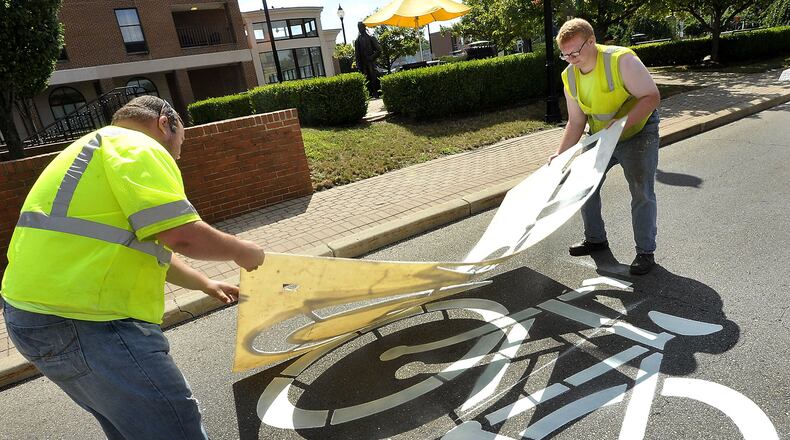Staying with the story
The Springfield News-Sun has written about the Springfield Bike Task Force since it was first announced in 2013 and examined how it could increase tourism and economic development.
By the numbers
207: Percentage bicycling ridership has increased since the 2000 U.S. Census.
100: Number of bike racks in Springfield, up from about 20 last year.
9: Number of members on the proposed Bicycle Advisory Committee.
The city has drafted a plan to increase bicycle use in Springfield, seeking to boost tourism and promote alternative transportation.
The Springfield Bike Plan was presented to city commissioners this week. It covers creating an advisory committee, complete streets policy, Share the Road campaign and increased enforcement of cycling and traffic laws.
The city has yet to capitalize on the trail system surrounding Springfield, said Jed Taylor, a member of the task force that drafted the bike plan. Cyclists often reach Beatty Station in Clark County and turn around, he said, but a plan to take the trail off some south side Springfield streets onto a dedicate path will attract tourists.
“Springfield has a real opportunity to tap into the tourism business,” he said. “Right now, Springfield is kind of missing out on that.”
After the Miami Valley Cycling Summit was held in Springfield in 2013, the city set up a task force to examine ways to increase cycling awareness.
Over the past 18 months, the 21-member task force held several community meetings to compile data and suggestions for the bike plan. During that time, several bike-oriented groups were formed including Bike Springfield, while the city also held a Bike to Work Day downtown.
The first step of the plan calls for setting up a bicycling advisory committee. That could include nine members from both local government and the community and may be set up in a few months, Deputy City Manager Bryan Heck said.
The proposed committee would provide recommendations to the city on how to implement the bike plan.
Ridership has increased about 207 percent in Springfield since the 2000 U.S. Census. The city’s ridership is currently more than larger cities like Columbus, Dayton, Cleveland and Cincinnati, according to census data. That likely can be attributed to the local trail system, the plan says.
With trails already in place around Springfield, Heck said the goal is to bring riders from the paths into the city. The plan also includes a trail map and a map of bike racks throughout the city.
The city hopes to use federal and state transportation money to execute the bike plan, Heck said.
“They’re making it a priority because they understand that it’s an important mode of transportation for many people in our country,” he said.
Setting up a committee will keep the task force’s momentum going strong, Taylor said.
“The very specific recommendations will have a group of people getting them done,” he said.
Last August, the city failed in its attempt to receive recognition as a bicycle friendly community by the League of American Cyclists, but gained important feedback, Heck said.
In June, the league rode through Springfield with staff and community members, offering suggestions on improvements. Springfield was one of 100 communities to be chosen for the session.
The city is in the process of purchasing right-of-way to create a multi-use trail to connect the existing segments of the Little Miami Trail. Currently, the trail runs mostly along city streets for nearly two miles between Springfield-Xenia Road and Fair Street. Recently, the Springfield Conservancy District provided grant money to hire off-duty police officers to patrol that section of trail.
That showed riders the trail is safer than perceived, Taylor said, and has also increased interaction with the community.
The completion of the trail will increase tourism and change the perception of the trail for cyclists, said Greater Springfield Convention and Visitors Bureau Director Chris Schutte. By seeking a bike friendly designation, it also shows cyclists the community is serious about carrying out its plan.
“It’s going to turn the page on where we are,” Schutte said.
During the planning process, the task force and other community stakeholders have completed several projects, including adding two bicycle repair stations, bicycle road markings downtown and a stairway leading from the bike path to the businesses on Home Road. The number of bike racks in the city has increased from 15 to 20 last year to more than 100 this year.
The task force also wants to adopt a complete streets policy for Springfield. The policy would make roads available to not just cars, but all modes of transit, including walkers and cyclists, Heck said.
The plan acknowledges that a complete streets policy could face political resistance if it’s required for every street. However Heck said the Miami Valley Regional Planning Committee adopted a policy where complete streets were available, but weren’t required for a community to receive transportation funding.
“It’s about looking at each roadway individually and what makes sense for that roadway,” Heck said.
Taylor previously served on a similar board in Missoula, Mont., that received a gold designation from the League of American Cyclists. The adoption of a complete streets policy there was key to earning a gold status, he said.
A large group of cyclists from North Carolina and from all over the area stopped at the Springfield Farmer’s Market a few weeks ago, City Commissioner Karen Duncan said.
“It’s just not serving our community … It’s also bringing people in from outside our community and hopefully spending money and spending the night here,” she said.
About the Author

